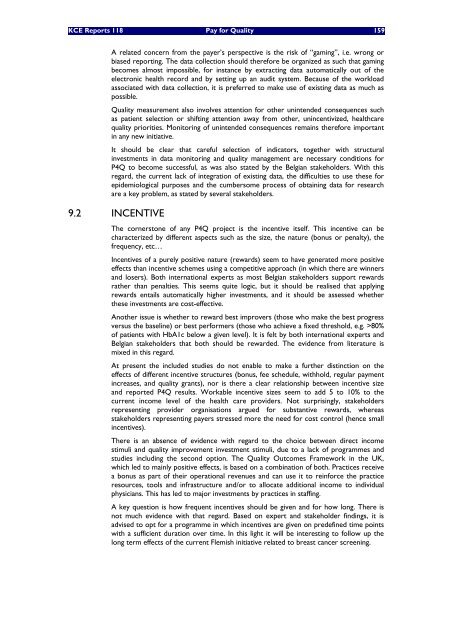Pay for Quality
Pay for Quality
Pay for Quality
You also want an ePaper? Increase the reach of your titles
YUMPU automatically turns print PDFs into web optimized ePapers that Google loves.
KCE Reports 118 <strong>Pay</strong> <strong>for</strong> <strong>Quality</strong> 159<br />
A related concern from the payer’s perspective is the risk of “gaming”, i.e. wrong or<br />
biased reporting. The data collection should there<strong>for</strong>e be organized as such that gaming<br />
becomes almost impossible, <strong>for</strong> instance by extracting data automatically out of the<br />
electronic health record and by setting up an audit system. Because of the workload<br />
associated with data collection, it is preferred to make use of existing data as much as<br />
possible.<br />
<strong>Quality</strong> measurement also involves attention <strong>for</strong> other unintended consequences such<br />
as patient selection or shifting attention away from other, unincentivized, healthcare<br />
quality priorities. Monitoring of unintended consequences remains there<strong>for</strong>e important<br />
in any new initiative.<br />
It should be clear that careful selection of indicators, together with structural<br />
investments in data monitoring and quality management are necessary conditions <strong>for</strong><br />
P4Q to become successful, as was also stated by the Belgian stakeholders. With this<br />
regard, the current lack of integration of existing data, the difficulties to use these <strong>for</strong><br />
epidemiological purposes and the cumbersome process of obtaining data <strong>for</strong> research<br />
are a key problem, as stated by several stakeholders.<br />
9.2 INCENTIVE<br />
The cornerstone of any P4Q project is the incentive itself. This incentive can be<br />
characterized by different aspects such as the size, the nature (bonus or penalty), the<br />
frequency, etc…<br />
Incentives of a purely positive nature (rewards) seem to have generated more positive<br />
effects than incentive schemes using a competitive approach (in which there are winners<br />
and losers). Both international experts as most Belgian stakeholders support rewards<br />
rather than penalties. This seems quite logic, but it should be realised that applying<br />
rewards entails automatically higher investments, and it should be assessed whether<br />
these investments are cost-effective.<br />
Another issue is whether to reward best improvers (those who make the best progress<br />
versus the baseline) or best per<strong>for</strong>mers (those who achieve a fixed threshold, e.g. >80%<br />
of patients with HbA1c below a given level). It is felt by both international experts and<br />
Belgian stakeholders that both should be rewarded. The evidence from literature is<br />
mixed in this regard.<br />
At present the included studies do not enable to make a further distinction on the<br />
effects of different incentive structures (bonus, fee schedule, withhold, regular payment<br />
increases, and quality grants), nor is there a clear relationship between incentive size<br />
and reported P4Q results. Workable incentive sizes seem to add 5 to 10% to the<br />
current income level of the health care providers. Not surprisingly, stakeholders<br />
representing provider organisations argued <strong>for</strong> substantive rewards, whereas<br />
stakeholders representing payers stressed more the need <strong>for</strong> cost control (hence small<br />
incentives).<br />
There is an absence of evidence with regard to the choice between direct income<br />
stimuli and quality improvement investment stimuli, due to a lack of programmes and<br />
studies including the second option. The <strong>Quality</strong> Outcomes Framework in the UK,<br />
which led to mainly positive effects, is based on a combination of both. Practices receive<br />
a bonus as part of their operational revenues and can use it to rein<strong>for</strong>ce the practice<br />
resources, tools and infrastructure and/or to allocate additional income to individual<br />
physicians. This has led to major investments by practices in staffing.<br />
A key question is how frequent incentives should be given and <strong>for</strong> how long. There is<br />
not much evidence with that regard. Based on expert and stakeholder findings, it is<br />
advised to opt <strong>for</strong> a programme in which incentives are given on predefined time points<br />
with a sufficient duration over time. In this light it will be interesting to follow up the<br />
long term effects of the current Flemish initiative related to breast cancer screening.
















